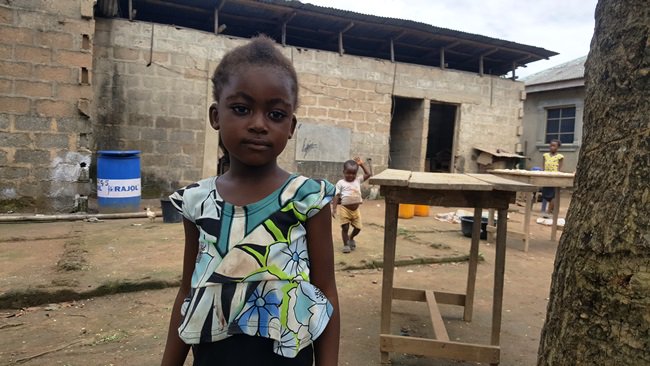
Six-year-old Beatrice Ogbor and her sibling Eliesar who has never witnessed electricity since birth.
Nigerian government, between 1999 and 2010, reportedly spent over N4.7 trillion on power, but the country is still in darkness. Eight years later, Jonathan and Buhari administrations invested another N1.164 trillion into through capital releases, yet homes and factories in Nigeria are yet to be provided with constant electricity supply.
In this report, Olugbenga ADANIKIN reports about the investments and wastage in the sector.
***
Beatrice Ogbor, a six-year-old basic one girl with her two-year-old sibling, was born into darkness and has never shared in the joy of the popular exclamation “Up NEPA” that follows power restoration in Nigeria.
“We gave birth to her here in 2014,” her father, John Ogbor (45) says. “You will be surprised; they have never seen electricity since birth”.
Ogbor is originally from Igede in Obi local government area of Benue state. For the past 14 years, he has been living in Moro, a community along Shagamu-Ikorodu expressway in Ogun state, after he left his original birthplace. But for almost seven years, his adopted community has been without electricity.
“We tried the little we can. As individual landlords, we contributed N40,000 to try make this electricity of a thing a reality. They said we should pay the money to process this and that to give us transformer, and we paid to Itesiwaju Area Community Council but at the end, nothing positive came out of it.”
For Ogbor, it has become almost hopeless waiting to access electricity in Moro, a community situated near the Nigerian Pipelines and Storage Company, a subsidiary of the Nigerian National Petroleum Corporation (NNPC) in Mosimi. Aside from its energy need, the community lacks access to healthcare, potable water, road and schools, an indication of total neglect by the government.
“God can still send help though, we believe,” says John. He paused for a moment, took a deep breath while gazing at his two children. “During campaign periods, we told them we don’t need rice, we don’t need money but electricity. That has been our only request.”
Similarly, Alasia, Iraye, Oremuti, Oponua, Likorodu, Imede and five other communities in Ogun State visited by The ICIR, shared the same fate or worse. For eight years, Oremuti community struggled to access power. Oponua has never been connected to the national grid for 10 years. These conditions are not peculiar to Ogun state but also other states across the country.
POLES ERECTED SINCE 1994 BUT HAVEN’T BEEN CONNECTED TO THE GRID
In Iraye community, Sagamu local government area, the first set of electricity poles, according to Rasheed Alimi, the community head, were erected in 1994. Till date, residents still live in darkness. A huge concrete platform constructed for the electrification project still lies adjacent the residence of Alimi when this reporter visited. It has neither transformer nor electricity cables except for about three electricity concrete poles sighted in the area.
Nearby is a multi-million naira 10-bed health care facility built by the NNPC, but it is off-the grid. Neglected and taken over by bush eight months after commissioning, the oil firm had installed a giant Mikano generator to service the clinic whenever it becomes operational but weeds also already have covered the generator.
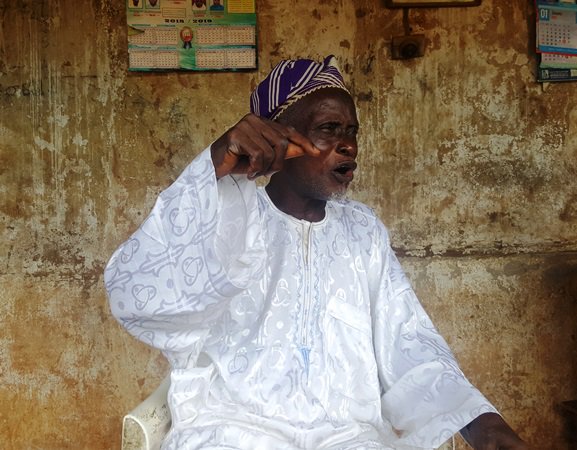
Rasheed Iraye, community head who had waited for 25 years to be connected to the national grid
Findings, however, revealed that the state assembly under administration of Ibikunle Amosun, governor of Ogun, approved in the 2013 budget the electrification of 32 communities, including Iraye. Closer look shows that the state ministry of rural development and rural electrification in Annexure II (B) listed the proposed benefitting communities but no such project exists today in Iraye.
OVER N1 TRILLION INVESTED IN POWER IN EIGHT YEARS
Nigeria generates its power via four main sources – hydro, gas, coal and natural gas. But for almost 20 years, huge unverified money has been expended into the sector. Specifically, The ICIR can authoritatively report that N1.164 trillion has been released to the power sector as capital budgets from 2011 to 2018, yet the power sector has not measured up – darkness still prevails. This figure was obtained from the office of the accountant-general of the federation.
Electrical power often generated is literally not commensurate with the huge investments. And returns on investments have largely been discouraging as the federal government continued to pump in more resources in terms of budgetary allocations, loans among other interventions to ensure the nation meet its energy need.
The Energy Business report (April 2016 vol. 15 no 160), shows that N6.52 trillion has been spent on Nigeria’s power sector in 16 years with no significant improvement. For example, ex-President Olusegun Obasanjo, the report says, allegedly spent N3.52 trillion ($16 billion) during his tenure, though this figure has been contested. Also, late President Umar Yar’adua was said to have spent N1.183 trillion, while the former President Goodluck Jonathan during his administration reportedly expended N1.817 trillion and President Muhammadu Buhari reportedly spent N1.5 trillion in two years, as at September.
Meanwhile, findings by The ICIR revealed that between 2011 and 2018, the office of the accountant-general of the federation had released capital sum of N1, 164,278,006,846 for power projects in the country.
These huge sum, however, exclude capital releases to six agencies between 2016 and 2018 namely, office of the surveyor-general of the federation, Federal School of Survey, Oyo, Federal Road Maintenance Agency (FERMA), Council for the Regulation of Engineering in Nigeria (COREN), Surveyor Council of Nigeria and Regional Centre for Training in Aerospace Survey when Buhari-led administration merged the power ministry with works and housing.
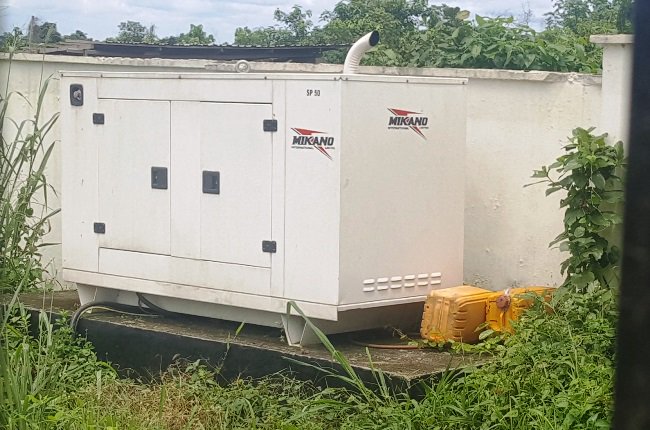
Power generating set provided for Iraye Primary Health Care Centre by the NNPC due to no power supply
WORLD BANK, AfDB, OTHER LOANS/GRANTS TO BOOST TRANSMISSION CAPACITY
In 2018, the Transmission Company of Nigeria (TCN) secured a total grant of $1.6 billion from international donors-World Bank, the African Development Bank (AfDB), Japan International Cooperation Agency (JICA), among others for its Transmission Rehabilitation and Expansion Program(TREP).Likewise, the French Development Agency committed $170 million for the Abuja Transmission Ring Scheme.
The World Bank gave $486 million to upgrade most of the transmission substations through its Nigeria Electricity Transmission Access Project (NETAP), Ogun-Lagos Transmission Project supported by JICA with $238 million, AfDB $300 million and 25 million Euros for the Northern Corridor Transmission Project, another $410 million AfDB Nigeria Transmission Expansion Project among other non-lending supports.
Most of these projects are either being implemented or at procurement stage, thus, not fully completed. For instance, the contract for the screening of 132KV lines NETAP project has been signed while consultant is billed for mobilisation before end of the year. The $170m Abuja transmission ring project is being implemented.
In terms of grants, TCN got 25 million Euro non-lending supports from the EU as part of funds to realise Northern Corridor Solar project, $13 million grant from the Japanese government through JICA for capacitor bank installation in Apo and Keffi, while the other $21 million grant also from JICA is to rehabilitate and upgrade Apapa road 132KV substation and 330KV Akungba sub station. “TCN is in discussion with JICA on more grant support from Japan,” the document from TCN read. It cannot, however, be established if these funds are part of the N1.5 trillion the current administration claimed it has spent on power in two years.
But reports also have it that while Dimeji Bankole was speaker of the house of representatives, 2,500 containers laden with imported power equipment allegedly worth $5 billion were left to rot at the Lagos Port with a demurrage of N4 billion.
“The containers were abandoned by incompetent contractors that were awarded projects beyond their capacities…some of the equipment were in demurrage for over 10 years,” TCN TREP document as of August 31 affirmed this, but put figure of the containers at 800.
In a 2017 report by The Guardian, the senate disclosed plan to probe alleged $1.35 billion power sector fraud in the country. The same report claimed $1 billion Eurobond was raised in 2013 to fund key power projects nationwide.

Ade in her sachet water factory
Princewill Okorie, APPA national president, in his speech delivered in July, in Abuja and obtained by The ICIR, further disclosed that about $35 million was set aside for the Afam East Power Projects and the sum was allegedly spent by federal ministry of power officials without any undertaking any feasibility study.
“Out of the $1 billion Eurobond, $350 million was given to Nigeria Bulk Electricity Trading Company in 2014. $29 million was purportedly paid to General Electric for turbines while $6 million was paid to others.”
However, in June, the EFCC announced the possibility of probing the power projects, especially those awarded during Obasanjo administration. This ultimately is to unravel the complexity and alleged corruption that has enmeshed the sector.
Despite the estimated sums so far invested in the sector, stable, uninterrupted power supply to Nigerians remains difficult to realise. Experts as well as other stakeholders have blamed this on poor investments, capacity and regulatory issues among others. While Nigeria can conveniently generate up to 20,000 mega watts (MWs), transmission has the capacity for about 8,000MW and distribution is still struggling between 2,000 and 4,000MW.
EPILEPTIC POWER CRIPPLING THE ECONOMY
The importance of stable power as driver of any country’s economy cannot be overemphasised as it is capable of transiting Nigeria from an under-developed to the much desired developed status, especially when industries, small and medium business enterprises (SMEs) are supported. But, as at date, 90 million Nigerians still lack access to power, a situation that has crippled SMEs and industries.
Apansile Ade, for instance, is an entrepreneur who operates water and paint factories. She had run the business for over five years but at a loss. She is currently operating the water factory because the paint business has gone under.
“We just stopped producing because the generator developed fault,” she told The ICIR. “Last week I spent almost N75, 000 repairing generator. I had to stop my son from resuming school on Monday because the little money I would have given to buy books, beverages was no longer there”.
Unfortunately, the community she resides since 2010 has never been connected to the grid. As a result, she bought six generators to power her house and the water factory. The last power generating set just collapsed when The ICIR visited.
“Let me say we have been struggling. As I’m speaking, we have generators that have packed up. We bought another generator recently since there is no electricity to run the business”.
She barely could account for profits made from the business, as effort was solely to satisfy her customers who, already, were tired of her inconsistent supply. “There is really nothing I can do since there is no electricity to boost the businesses,” she said.
“…just that we don’t want to lose customers. One was telling me yesterday that we don’t know how to run business.”
The entrepreneur had bought four generators in five years of business. She listed unit costs of each as N500,000, N300,000, N400,000 and N250,000 summed to N1.450 million. She also spends N95,000 monthly on fuel and N80,000 on maintenance. This, however, implies that in five years, she had spent N10.5 million getting fuel for the generator as well as its maintenance.
Two streets from her house is a POS business point and computer business centre, both under lock in the normal business hours. Opposite the shop is another beauty salon opened but appeared less operational.
At the main street to Apansile’s residence is Abayomi Olusada’s welding workshop, situated opposite a tailor’s shop and divided by erosion threatened road. Apparently, the 56-year-old man was home when the reporter visited – there was no sign to show he had been to the workshop for days. He started welding business 35 years ago in Lagos, but since 2009 when he moved to Oponua community, it has been sad tales.
“Electricity has been a serious challenge for us in this community. Unfortunately, there is no one to finance us to get connected,” says Olusada. Apparently, the community resolved to facilitate and procure whatever material needed to get connected to the grid after years of waiting on government and power officials.
“A lot of people have left this community; even landlords had to relocate leaving their homes. So, it’s really a big problem affecting my business. Though, I may make use of generator when there is power outage, but electricity is vital,” Olusada added hitting his right fist at his left palm to drive home his point.
“Even when I get contracts, I spend 50 per cent of the money on fuel. In the process, the generator develops fault and I had to start looking for money to fix it.”
Regrettably, beyond travails of small businesses, Nigeria is said to spend an estimated $13 billion to purchase generators annually, all to fix industrial, commercial and domestic energy need. As at 2016, Energy Business say over N796.4 billion was spent on fuel to power those generators.
One of the foremost telecommunications companies in the country, MTN, also claimed it fuels 6,000 power generating sets which run for 19 hours daily. Likewise, Manufacturers Association of Nigeria (MAN) revealed in 2017 that its members spent N213.77 billion on alternative power sources just in two years – 2014 and 2016.
GOVERNMENT HOARDS INFORMATION
In order to ascertain the exact amount sunk into the power sector, FOI request was sent to the ministry of power. The ministry acknowledged the receipt of the request and promised to respond. Weeks after, the ministry is yet to send a reply.
Efforts, through FOI requests from The ICIR to access copy of the power sector shared agreement, which the federal government signed with the unbundled companies, failed. The power ministry acknowledged same letter but referred to the National Electricity Regulatory Agency (NERC) and the Bureau of Public Enterprise (BPE). But up till date, the document was not provided. BPE claimed one of the power agreements is being investigated by the EFCC. However, the EFCC has remained numb on the claim after several attempts to verify.
ABANDONED PROJECTS LIMITING NIGERIA
In 2000, the federal government initiated the process of unbundling the electricity sector. National Electric Power Authority (NEPA) becomes partly privatised with the appellation – Power Holding Company of Nigeria (PHCN). The National Council on Privatisation (NCP) under chairmanship of Atiku Abubakar eventually led a 23-member Electric Power Sector Reform Implementation Committee (EPIC) that developed the National Electric Power Policy direction for a private-sector driven power development in the country.
In 2000, Olusegun Agagu, former minister of power and steel, said: “By our choice of privatisation, the framework for resolving the crisis that constituted a serious bottleneck in the past is being put in place.
“We are, through this policy document extending invitations to investors and other stakeholders in the power sector, the world over, to avail themselves of the abundant opportunities that the reform, restructuring and privatisation of Nigeria’s electricity industry offer”.
However, in 2013, the privatisation took effect with the federal government having 40 percent stake in power distribution companies. NEPA unbundling led to Generation Companies (GenCos), 11 Distribution Companies (DisCos), Niger Delta Power Holding Company (NDPHC) National Independent Power Projects (NIPP) – owned by the federal, state and local government, Transmission Company of Nigeria (TCN), Nigerian Bulk Electricity Company (NBET) and the recent metering companies.
It is believed that upon privatisation, power generation, transmission and distribution would significantly improve, but that has not happened. Rather, findings showed that majority of the power infrastructure inherited by investors are obsolete. More so, they are either partially operational or left in ruins. For instance, Omoku and second unit of Gbarain NIPP as well as Egbema have not been fully completed since 2005.
A source at the Niger Delta Power Holding Company Limited (NDPHC) who pleaded anonymity, however, said Olorunsogo II, Geregu II, Calabar and Alaoji have been completed and functional. But noted how four others – Omotosho, Benin, Ogorode and Egbema were mostly shutdown due to power rejection to the national grid. This, he said, puts the NDPHC at huge losses considering the cost of generating those powers including gas to power the NIPPs plants.
“Since NERC and TCN had issues a couple of years back on load transmission, the National Control Centre, at times does not pick the power generated because they want to avoid the blame game,” says the source. “Some of the DisCos also have their shortcomings which largely depend on their distribution capacities. For instance, if a substation is 33 KVA, the DisCos cannot definitely take anything above the 33KVA”.
Major hydro-power project such as the Mambilla and Kashimbilla remain uncompleted years after commencement.
Ironically, while the federal government strives to achieve significant fete on the outstanding power contracts, it is considering nuclear technology as new power source.
During the investigation, The ICIR visited Omoku Generation Company Limited 264.7MW and 225MW power project awarded to Rockson Engineering Company Limited, which is located in Omoku community, Ogba/Egbema/Ndoni local government area of Cross River state.
The military and private security officials guarded the uncompleted facility, which was awarded 14 years ago. In November 2017, the NDPHC promised Omoku and three other plants – 750MW Alaoji, 338MW Egbema and 225MW in Bayelsa would be completed before third quarter of 2018 but that’s not entirely the case.

Olusada has abandoned his shop
The ICIR’s visit to Omoku project site which also accommodates a state-owned power project, revealed that the facility had since 2018 been taken over by the Asset Management Company of Nigeria (AMCON).
Apparently, there are two power projects on the site. While one is operational, the other is not. At the main entrance is a giant blue gate manned by military personnel and private security. Opposite the gate, is green scenery beautifying the well-planned layout. But this reporter was not allowed access into the facility by the security men on duty. However, few workers retained by AMCON, who spoke anonymously, said the power project was taken over due to inability of the contractor to deliver. “It’s been long they have been on the project and AMCON has taken it over,” a source said.
Meanwhile, earlier findings by the reporter revealed there is Omoku I and II gas-powered project. While the first 150 MW plant was listed as completed and ‘operational’, 225MW Omoku II power project is non-operational and uncompleted. But, the source insists, “This one is state, and the other which is on-going, is federal” stressing that the active project does not belong to the FG.
“As far as I’m concerned and what I know, it is only this one,” pointing at the state-owned project, “that is operational. The one of federal – nothing has been done there. Look, you will only see that building and some installations”.
“Nothing has been done,” expressing surprise at the reporter’s unawareness. “Except there is another but if it is this one, all they are saying is fallacy.”
The reporter made another attempt to persuade the source to allow him gain entrance into the premises, but to no avail. “…The people in the camp are old Rockson staff like mechanics, drivers and their internal security,” the source said. “Most times, they only visit and go back. AMCON officials too just come for inspection and goes back…they took over early this year because of the lackadaisical work of the company. It appears they have not awarded it to a new company.” The source added and drove off.
“I must say that the ones that have not been completed have been under one contractor, Rockson Engineering due to contractor delay. But we have found a way around the contractor issue now,” Chiedu Ugbo, NDPHC Managing Director had said in 2018.
According to him, NDPHC is working with AMCON, which has taken over the contractor under a receivership, to complete the projects.
“I cannot tell you details about the place but all I know is work has not started. The work is not yet completed. I cannot take you inside. I don’t have that mandate because I have my limit,” a retired police officer told The ICIR.
However, a look at the facility from the fence behind revealed rusty giant iron pipes and equipment. The NIPP project cannot be seen from the main entrance, except for the state-owned which Wisdom; a private security guard, said was sold to First Independent Power Limited (FIPL).
SUSTAINABLE SOLUTIONS TO RIGHT THE WRONGS
In the face of these challenges various experts have argued the need for the government to embrace renewable energy. Some also called for the rehabilitation of obsolete power equipment. “To address the problems, stakeholders including the federal government must try and invest in key infrastructure such as gas pipelines, equipment used in the distribution, generation and transmission of electricity, and other facilities,” says Marcel Hochet, president, Green Elect, in an interview with The Nation newspaper.
“Of note is the use of obsolete equipment such as transformers, feeders, sub-stations and others that need to be replaced with new ones by power distribution companies (DisCos) to adequately supply power to the consumers. Since the operators are not having enough money to play around with, they need to bring in more investors into the industry to provide the fund needed to move the sector forward.”
The ICIR visited NDPHC headquarters to verify why some of the NIPP projects are not fully operational and others uncompleted but Yakubu Lawal, the firm’s general manager, communication and public relations, was absent. Calls to his phone rang but were later put on voice mail. Text messages sent to him also was not returned.
However, two top sources in the NDPHC, acknowledged failed status of the Omoku Power project. One of them told The ICIR that the Economic and Financial Crimes Commission (EFCC) are currently investigating the contractor – Rockson Engineering Company Limited for its inability to successfully complete the project, years after it was awarded. He noted that legal department of the company had filed a suit against the contractor, saying all projects handled by Rockson, the only local contractor, are poorly executed.
“AMCON is only trying to rescue the plant for us,” the source said, adding, “So far, NDPHC is working with AMCON. We are also following the case instituted by the EFCC against the contractor”.
President Muhammadu Buhari, had in September, instructed the anti-graft agency to probe and prosecute those involved in the failed project. As such, the EFCC officials picked two officers of the NDPHC while the alleged $16 billion is being probed. But several probes conducted by the national assembly or the anti-graft agency have not produced any sanction. As a result, civil society organisations challenged the EFCC to expedite action on the prosecution process.
However, as of October 4, the source put the combined electricity generated from the eight NIPPS at 468.7MW but noted that only 200 to 300MW finally gets to the consumers.
At the Manufacturers Association of Nigeria office in Abuja, a top official, who preferred not to be mentioned, said members of the association currently spend N93.1 billion annually on alternative power generation.
This, he said, discourages investors from venturing into businesses in the country. In a sane clime, manufacturers have no business generating power except to import machines and start production, he said.
“When you are on power, equipment must not stop otherwise, it could damage the raw materials and the equipment itself,” the source said. “That is why most manufacturing companies run on alternative power source which cost them N93.1 billion annually.” Despite, all the concerns, MAN insists genuine privatisation remains the answer to addressing the nation’s power problem. “Foreigners with financial strength and good expertise should be allowed to manage the sector not like the previous privatisation we had.”
In conclusion, there is need to have a paradigm change in approaches to the generation, transmission and distribution of electricity in the country.
This report is part of a collaborative investigative series by Daily Trust, the International Centre for Investigative Reporting (ICIR), Premium Times and TheCable, facilitated by the Wole Soyinka Centre for Investigative Journalism (WSCIJ) under its Regulators Monitoring Programme (REMOP) for the Electricity Sector, with support from the John D. and Catherine T. MacArthur Foundation.
***
Source: TheCable
You may be interested

2024 CHANQ: History Not Kind To Us Against Ghana –Ogunmodede
Webby - December 24, 2024Home-based Super Eagles coach Daniel Ogunmodede says history has not been good to Nigeria when they face rivals Ghana.The home-based…

Ex-Chelsea Star Oscar Returns To Boyhood Club Sao Paulo
Webby - December 24, 2024Former Chelsea midfielder Oscar is returning to his Brazilian boyhood club Sao Paulo after 14 years, which included a long…

‘I’m Incredibly Proud’– Arokodare Talks Up Genk’s Unbeaten Home Streak
Webby - December 23, 2024Tolu Arokodare is full of excitement followingGenk’s historic victory over Anderlecht, reports Completesports.com.Sunday’s win at the Cegeka Arena was the…







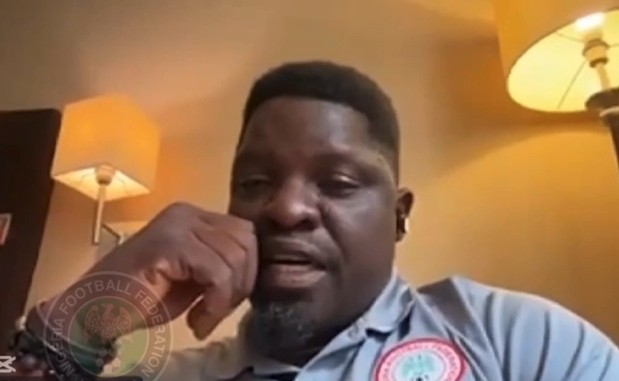


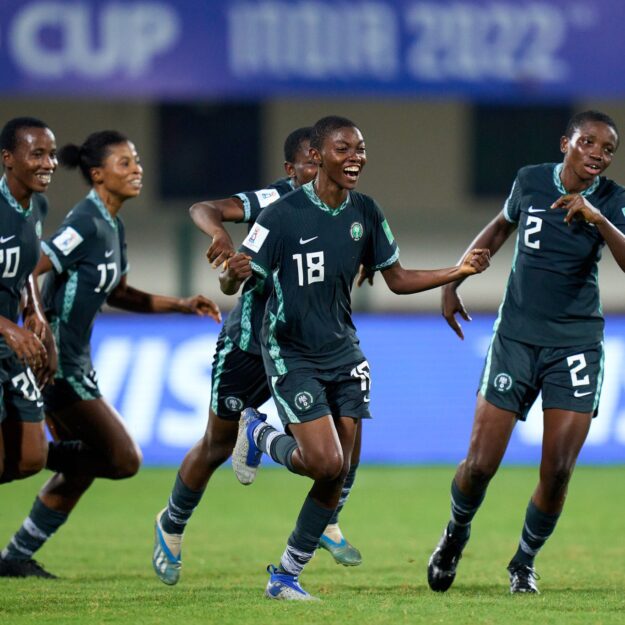




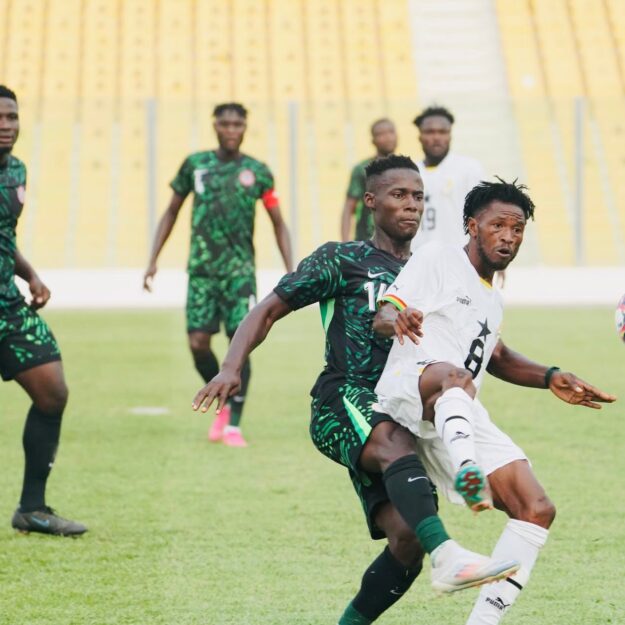


![American Pastor, David Wilson Seen Eating The Box Of Woman Who Isn’t His Wife [Video]](https://onlinenigeria.com/wp-content/uploads/2019/10/american-pastor-david-wilson-seen-eating-the-box-of-woman-who-isnt-his-wife-video-150x150.jpg)









